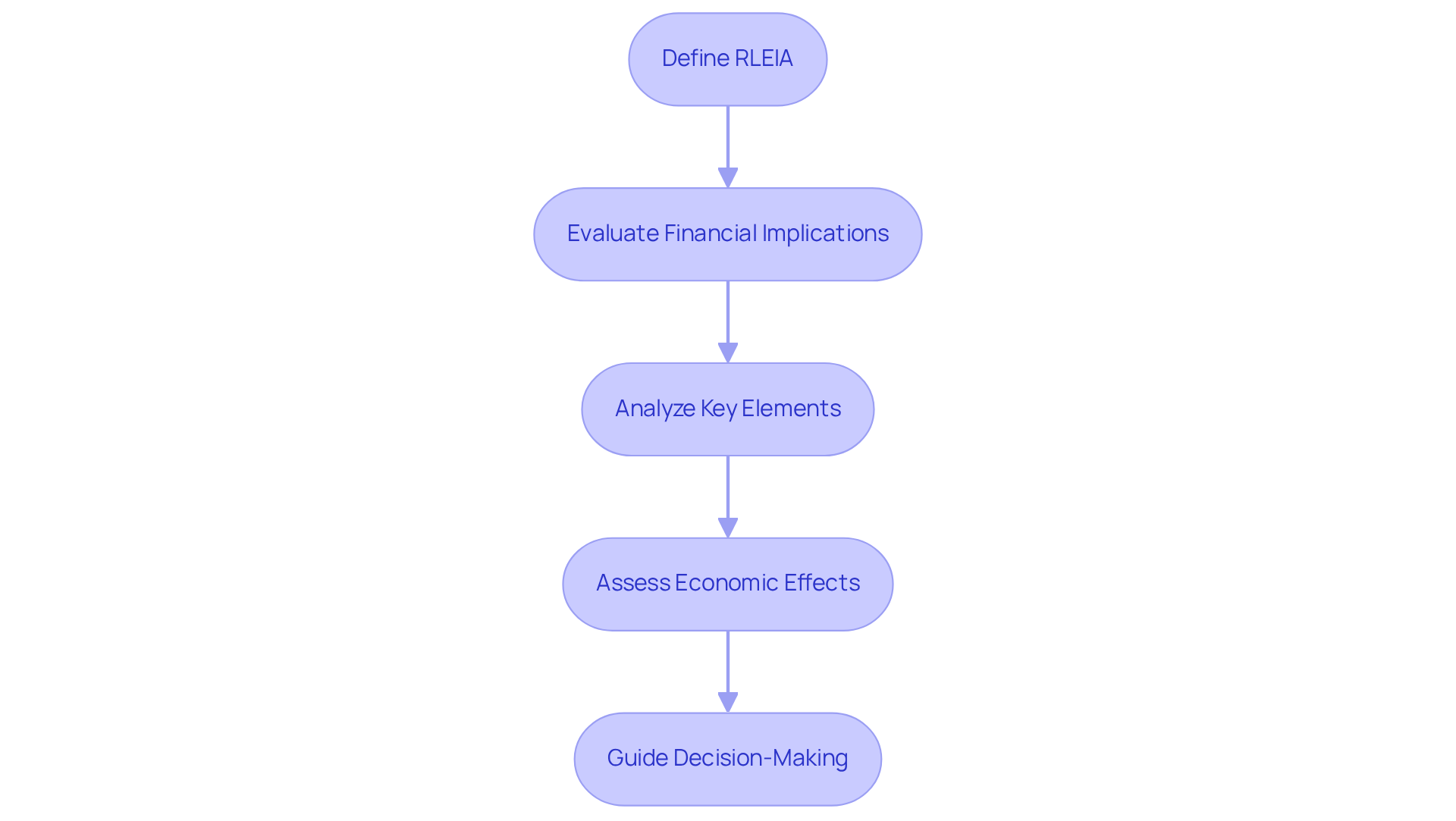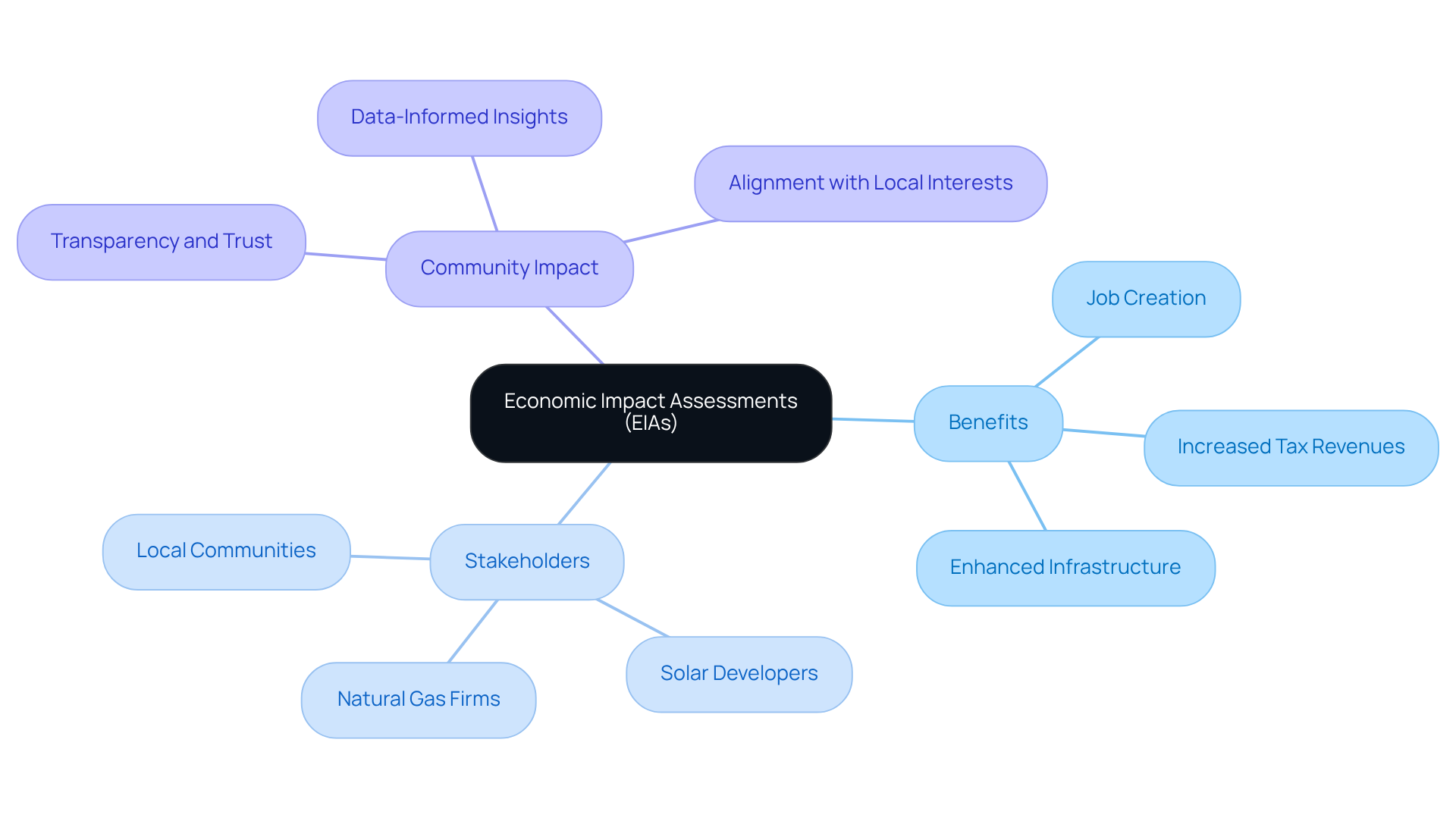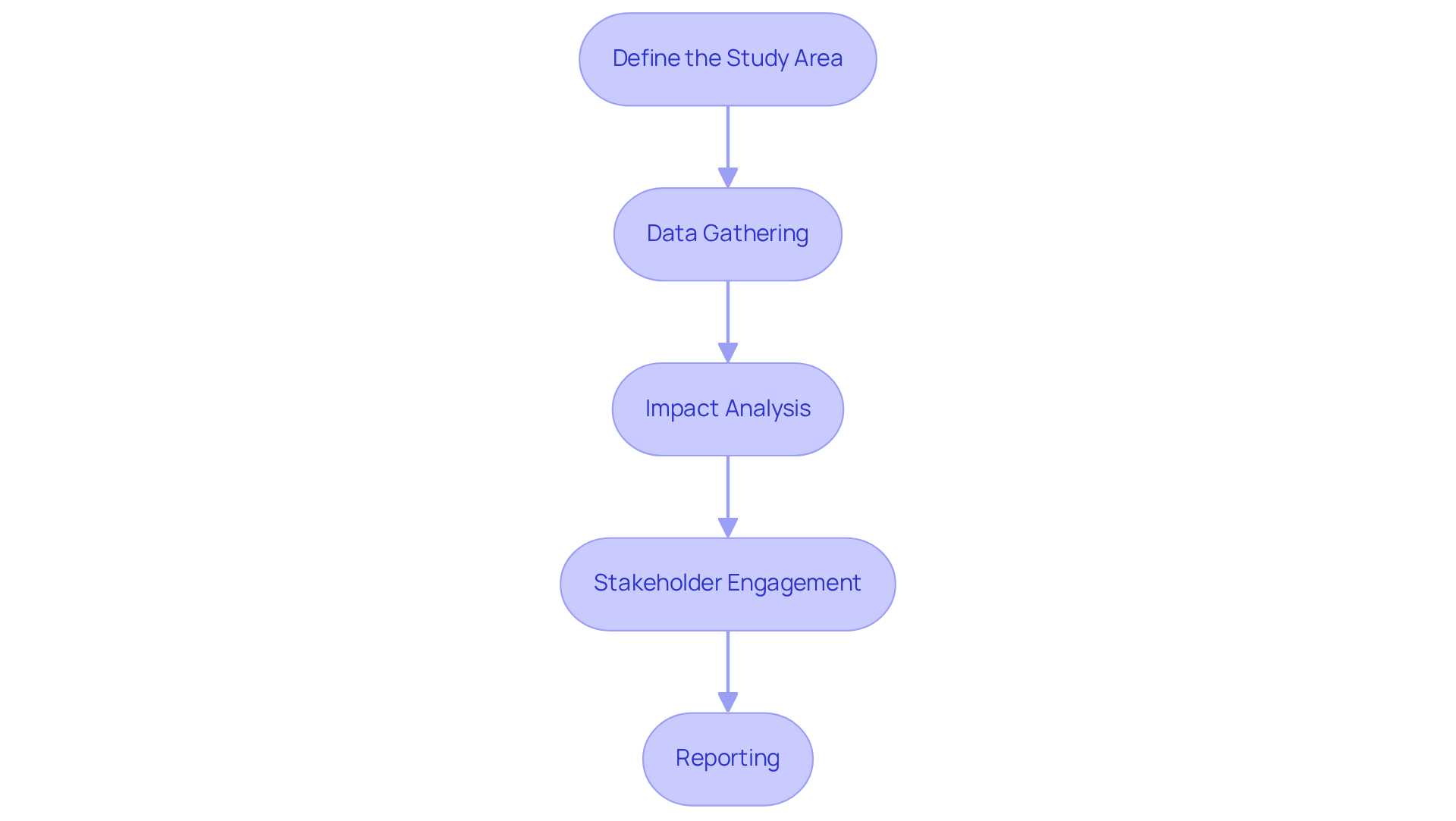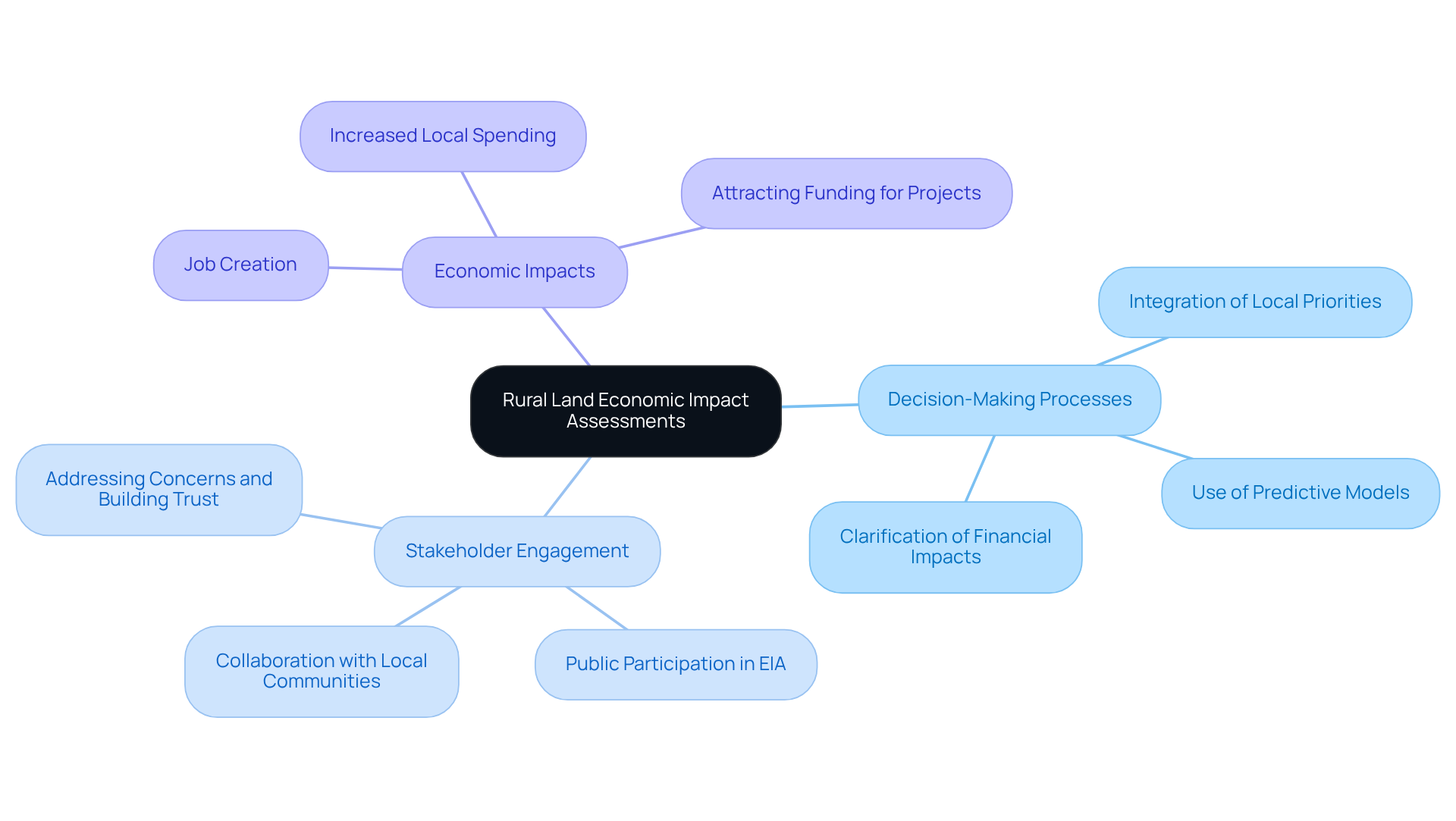Overview
Rural land economic impact assessments (RLEIAs) serve as essential evaluations that scrutinize the financial ramifications of land use changes, development projects, or policy implementations in rural regions. These assessments focus on the economic effects, including job creation and income generation. RLEIAs are crucial in guiding informed decision-making for stakeholders by systematically evaluating economic impacts and fostering community engagement. This process ultimately promotes sustainable development that aligns with local needs.
Introduction
Rural land economic impact assessments (RLEIAs) are essential for grasping the financial implications of land use changes, development projects, and policy shifts in rural communities. These assessments deliver a thorough analysis of both direct and indirect economic effects, enabling stakeholders to confidently navigate the complexities of land acquisition and development.
As rural economics continue to evolve, stakeholders must consider:
- How can they ensure their decisions align with the best interests of local communities while promoting sustainable growth?
This question underscores the need for a strategic approach that balances economic development with community welfare.
Define Rural Land Economic Impact Assessments
Rural land economic impact assessments (RLEIAs) are essential evaluations that examine the financial implications of changes in land use, development projects, or policy implementations in rural areas. Rural land economic impact assessments are crucial for understanding both direct and indirect economic effects on surrounding areas, including job creation, income generation, and overall economic growth. Have you considered how energy projects might impact your local economy? For example, rural land economic impact assessments can illustrate how such initiatives contribute to local economies by generating jobs and stimulating income through increased demand for local services and goods.
By meticulously analyzing key elements such as property acquisition, resource distribution, and public involvement, rural land economic impact assessments provide essential insights that guide decision-making for stakeholders involved in energy and infrastructure projects. This systematic approach not only aids in comprehending the financial landscape but also fosters informed planning and investment strategies that align with community development objectives. The complexities of land acquisition, including legal and regulatory challenges, can be daunting. However, through effective RLEIAs, organizations can navigate these challenges and offer solutions that benefit all stakeholders involved.
In conclusion, rural land economic impact assessments are essential tools for understanding the economic impacts of changes in land use. They empower stakeholders to make informed decisions that promote sustainable development and enhance community well-being.

Contextualize the Importance of Economic Impact Assessments in Land Acquisition
Economic Impact Assessments (EIAs) play a vital role in property acquisition by offering a thorough analysis of the economic consequences tied to usage decisions. In rural settings, rural land economic impact assessments empower stakeholders—such as natural gas firms and solar developers—to gauge the potential impacts of their projects on regional economies.
For instance, EIAs can reveal opportunities for job creation, increased tax revenues, and enhanced infrastructure, thereby justifying the need for land acquisition. The recent announcement by the EPA of $2 billion in infrastructure funding for rural water supplies highlights the significance of rural land economic impact assessments in strengthening regional economies.
Moreover, EIAs promote stakeholder engagement by delivering data-informed insights that address public concerns and expectations, ultimately fostering transparency and trust throughout the acquisition process. This proactive approach not only enhances project feasibility but also aligns development efforts with the financial interests of local communities.
As economist Diane Reilly points out, grasping the socioeconomic impacts is essential for navigating regulatory requirements and ensuring that projects yield benefits for both developers and the communities they influence.

Outline Methodology for Conducting Economic Impact Assessments
Conducting a Rural Land Economic Impact Assessment entails several essential steps:
-
Define the Study Area: Clearly delineate the geographical boundaries relevant to the assessment. This ensures that all financial activities within this area are comprehensively considered.
-
Data Gathering: Utilize a combination of quantitative and qualitative approaches to collect information on regional financial conditions. Examine employment rates, income levels, and current usage patterns, which are crucial for comprehending the present financial environment. For instance, with nearly 37% of the contiguous U.S. experiencing drought conditions, assessing how these factors impact local economies is imperative.
-
Impact Analysis: Apply advanced financial modeling techniques, such as Input-Output analysis or Computable General Equilibrium models, to estimate the direct, indirect, and induced financial impacts resulting from proposed land use changes. These methodologies provide a robust framework for rural land economic impact assessments, particularly in light of fluctuating commodity prices and historic highs in cattle prices.
-
Stakeholder Engagement: Actively involve community stakeholders throughout the assessment process. This engagement is vital for gathering insights, addressing public concerns, and ensuring that the assessment aligns with local values and priorities. As U.S. Secretary of Agriculture Brooke Rollins emphasized, timely support for producers facing market uncertainty is essential, making stakeholder input invaluable.
-
Reporting: Compile the findings into a detailed document that outlines the expected financial impacts. This report should offer practical suggestions for decision-makers, enabling informed choices that reflect the needs of the population. Utilizing case studies, such as the "Customized Economic Analysis for Agricultural Initiatives," illustrates how tailored assessments lead to informed decision-making and enhance stakeholder engagement.

Discuss Implications for Decision-Making and Stakeholder Engagement
Rural land economic impact assessments (RLEIAs) are crucial for shaping decision-making processes and improving stakeholder engagement. They clarify the financial impacts of changes in land use, enabling stakeholders to make informed decisions that resonate with local priorities. For example, when a solar developer conducts an Environmental Impact Assessment (EIA), they can highlight potential economic benefits, such as job creation and increased local spending, to secure community support. Engaging stakeholders throughout the evaluation process fosters a collaborative environment where concerns are recognized, leading to more sustainable and widely accepted land use decisions.
Moreover, statistics indicate that effective stakeholder engagement significantly enhances the quality of land use decisions by incorporating diverse perspectives. Rural land economic impact assessments serve as a crucial link between project developers and local communities, ensuring that economic considerations are at the forefront of land acquisition strategies. This approach not only addresses the complexities of legal and regulatory challenges but also positions organizations to provide effective solutions tailored to the needs of the community.

Conclusion
Rural land economic impact assessments (RLEIAs) are essential tools for evaluating the economic implications of land use changes in rural areas. These assessments systematically analyze the financial consequences of development projects, empowering stakeholders to make informed decisions that align with community needs and foster sustainable growth.
This article has provided key insights into the methodology of conducting RLEIAs. It covers:
- Defining study areas
- Gathering relevant data
- Performing impact analyses
- Engaging stakeholders
- Reporting findings
Each step is crucial in ensuring that the assessments yield actionable insights that address both economic and community concerns. Notably, the importance of stakeholder engagement has been emphasized, illustrating how effective communication fosters transparency and trust, ultimately leading to more favorable outcomes for all parties involved.
In a broader context, the significance of RLEIAs cannot be overstated. They not only facilitate informed decision-making but also enhance community well-being by ensuring that local values and priorities are reflected in development initiatives. As rural areas face increasing pressures from various land use changes, embracing RLEIAs is essential for fostering economic resilience and sustainable development. Stakeholders are encouraged to prioritize these assessments to navigate complexities and create lasting benefits for their communities.
Frequently Asked Questions
What are Rural Land Economic Impact Assessments (RLEIAs)?
RLEIAs are evaluations that examine the financial implications of changes in land use, development projects, or policy implementations in rural areas, focusing on both direct and indirect economic effects.
Why are RLEIAs important?
RLEIAs are crucial for understanding the economic effects of land use changes, including job creation, income generation, and overall economic growth in rural areas.
How can RLEIAs illustrate the impact of energy projects on local economies?
RLEIAs can demonstrate how energy projects contribute to local economies by generating jobs and increasing demand for local services and goods, thereby stimulating income.
What key elements are analyzed in RLEIAs?
Key elements include property acquisition, resource distribution, and public involvement, which provide insights for decision-making regarding energy and infrastructure projects.
How do RLEIAs assist stakeholders in planning and investment?
By offering a systematic approach to understanding the financial landscape, RLEIAs help stakeholders develop informed planning and investment strategies that align with community development objectives.
What challenges can RLEIAs help navigate?
RLEIAs can help organizations navigate the complexities of land acquisition, including legal and regulatory challenges, by offering solutions that benefit all stakeholders involved.
What is the overall goal of conducting RLEIAs?
The overall goal is to empower stakeholders to make informed decisions that promote sustainable development and enhance community well-being in rural areas.
List of Sources
- Define Rural Land Economic Impact Assessments
- USDA Invests $80 Million to Expand Timber Markets, Protect Forests, Fuel Economic Growth (https://usda.gov/about-usda/news/press-releases/2025/07/17/usda-invests-80-million-expand-timber-markets-protect-forests-fuel-economic-growth)
- Executive Summary: An Initial Economic Impact Estimate of Agritourism in Oregon’s Willamette Valley (https://extension.oregonstate.edu/catalog/pub/em-9421-fs-executive-summary-initial-economic-impact-estimate-agritourism-oregons)
- Assessing the Socio-Economic Impacts of Rural Infrastructure Projects on Community Development (https://mdpi.com/2075-5309/12/7/947)
- Why the 2025 Farm Bill Matters for County-Level Economic Growth (https://keatax.com/why-the-2025-farm-bill-matters-for-county-level-economic-growth)
- Contextualize the Importance of Economic Impact Assessments in Land Acquisition
- Economic Impact Assessments | Share Project Stories | TRC (https://trccompanies.com/insights/using-economic-impact-assessments-to-share-the-story-of-a-project-or-facility)
- 30 Inspiring Real Estate Quotes That Will Change Your Life (https://realwealth.com/learn/real-estate-quotes)
- Media Quotes on COVID-19 Economic Impact - Georgia State Economic Forecasting Center (https://efc.robinson.gsu.edu/about-the-director/media-quotes-on-covid-19-economic-impact)
- Outline Methodology for Conducting Economic Impact Assessments
- Economic Impact Analysis (https://decision-innovation.com/solution/economic-impact)
- Quotable Quotes: Stadium Subsidies are a Terrible Investment for Taxpayers (https://mercatus.org/economic-insights/expert-commentary/quotable-quotes-stadium-subsidies-are-terrible-investment)
- USDA Expediting $10 Billion in Direct Economic Assistance to Agricultural Producers | Farm Service Agency (https://fsa.usda.gov/news-events/news/03-18-2025/usda-expediting-10-billion-direct-economic-assistance-agricultural)
- Discuss Implications for Decision-Making and Stakeholder Engagement
- Engaging and empowering communities and stakeholders in rural land use and land management in Scotland (https://gov.scot/publications/engaging-empowering-communities-stakeholders-rural-land-use-land-management-scotland/pages/7)
- DevInsights (https://devinsights.co.in/blogs/unlocking-success-a-comprehensive-guide-to-effective-impact-assessment-strategies)
- Stakeholder Engagement In Environmental Impact Assessment - FasterCapital (https://fastercapital.com/topics/stakeholder-engagement-in-environmental-impact-assessment.html/1)




